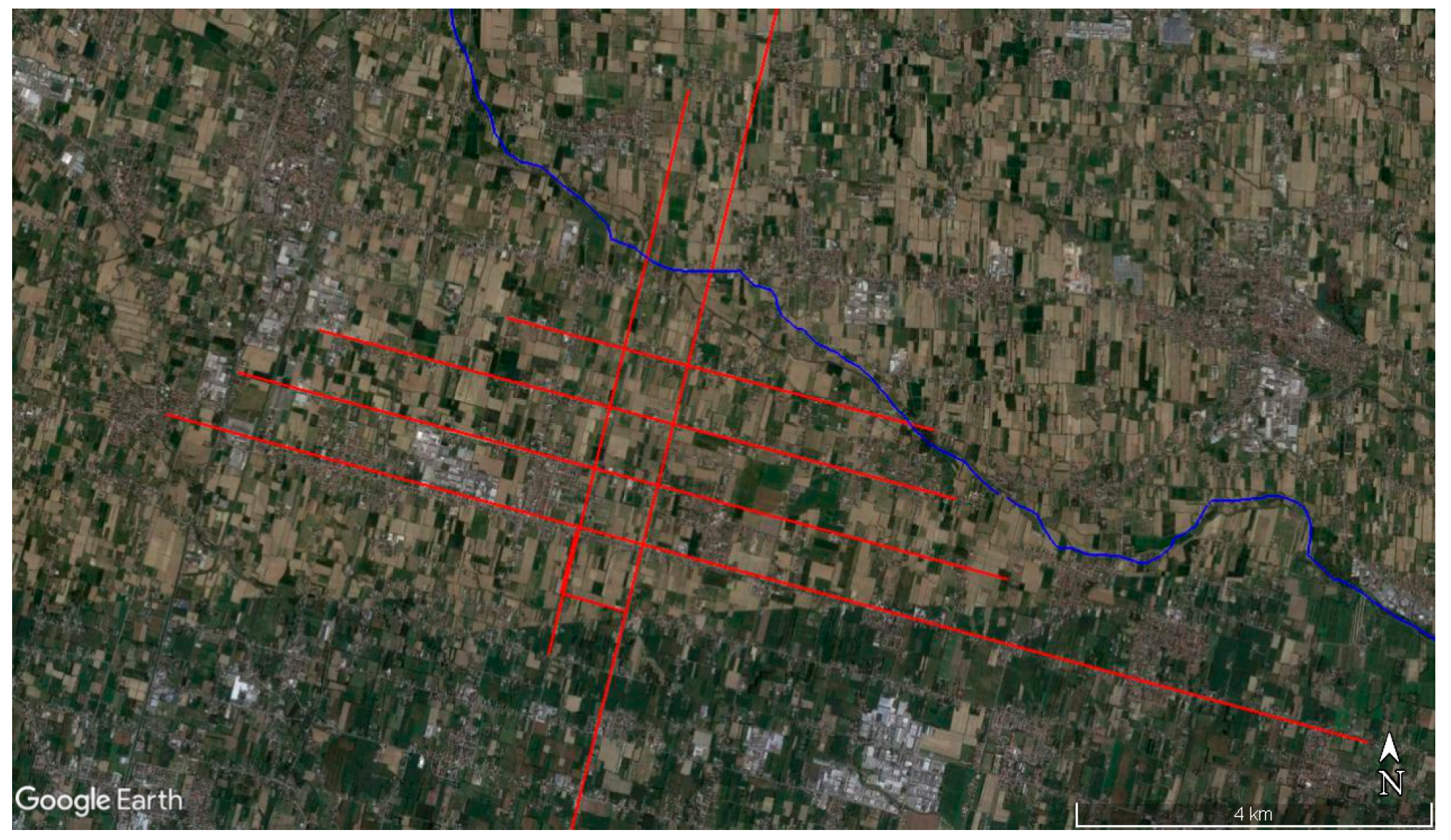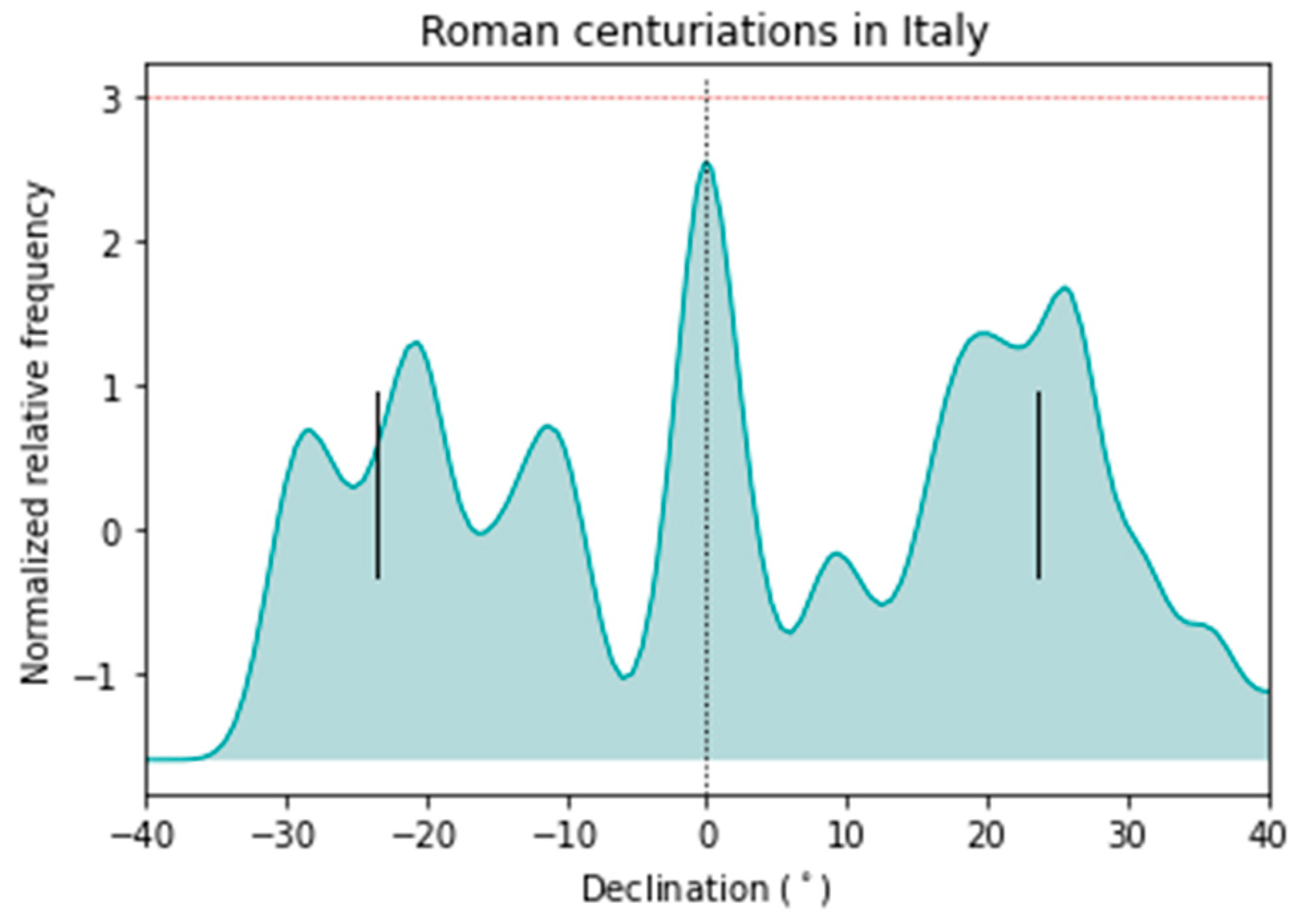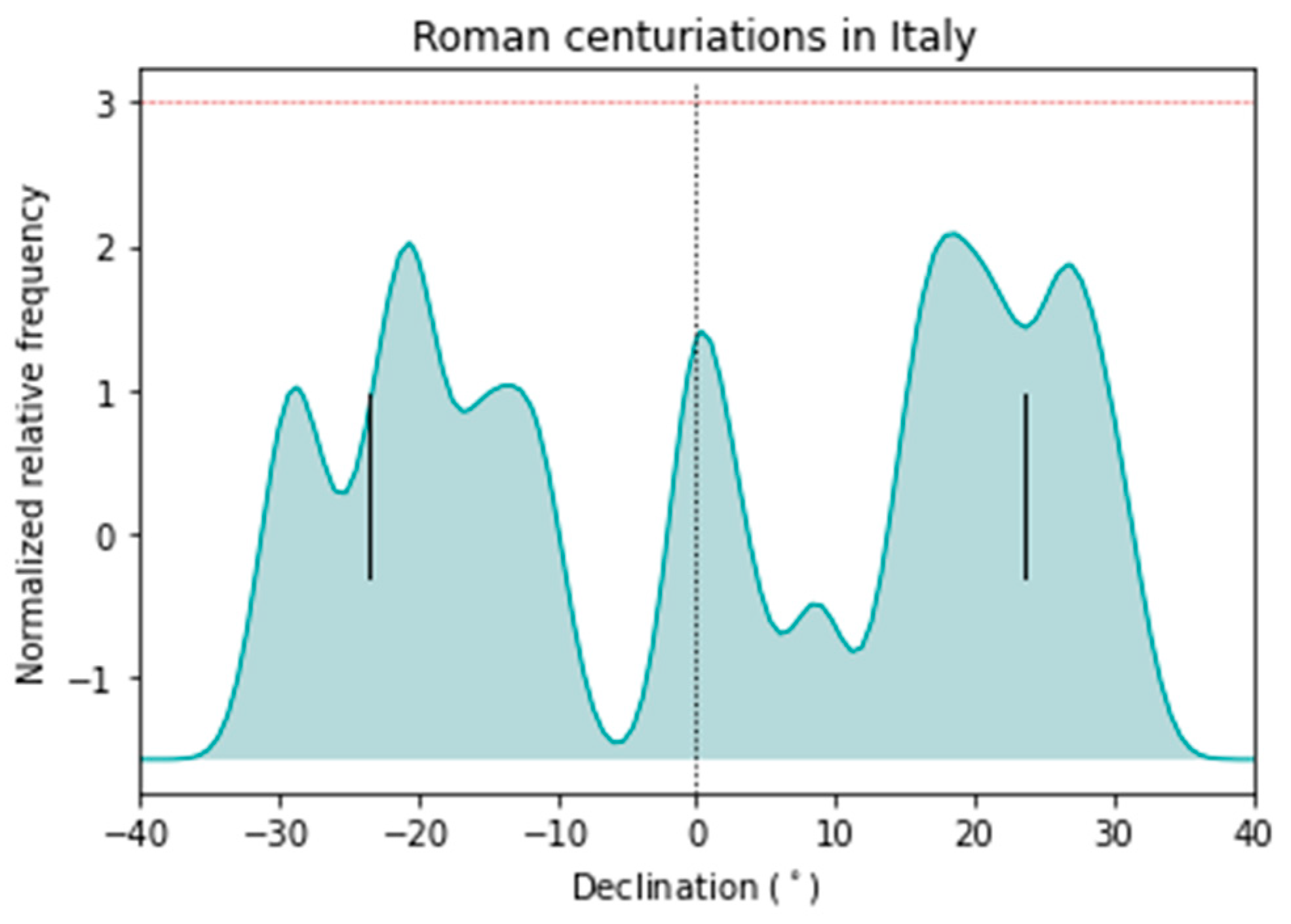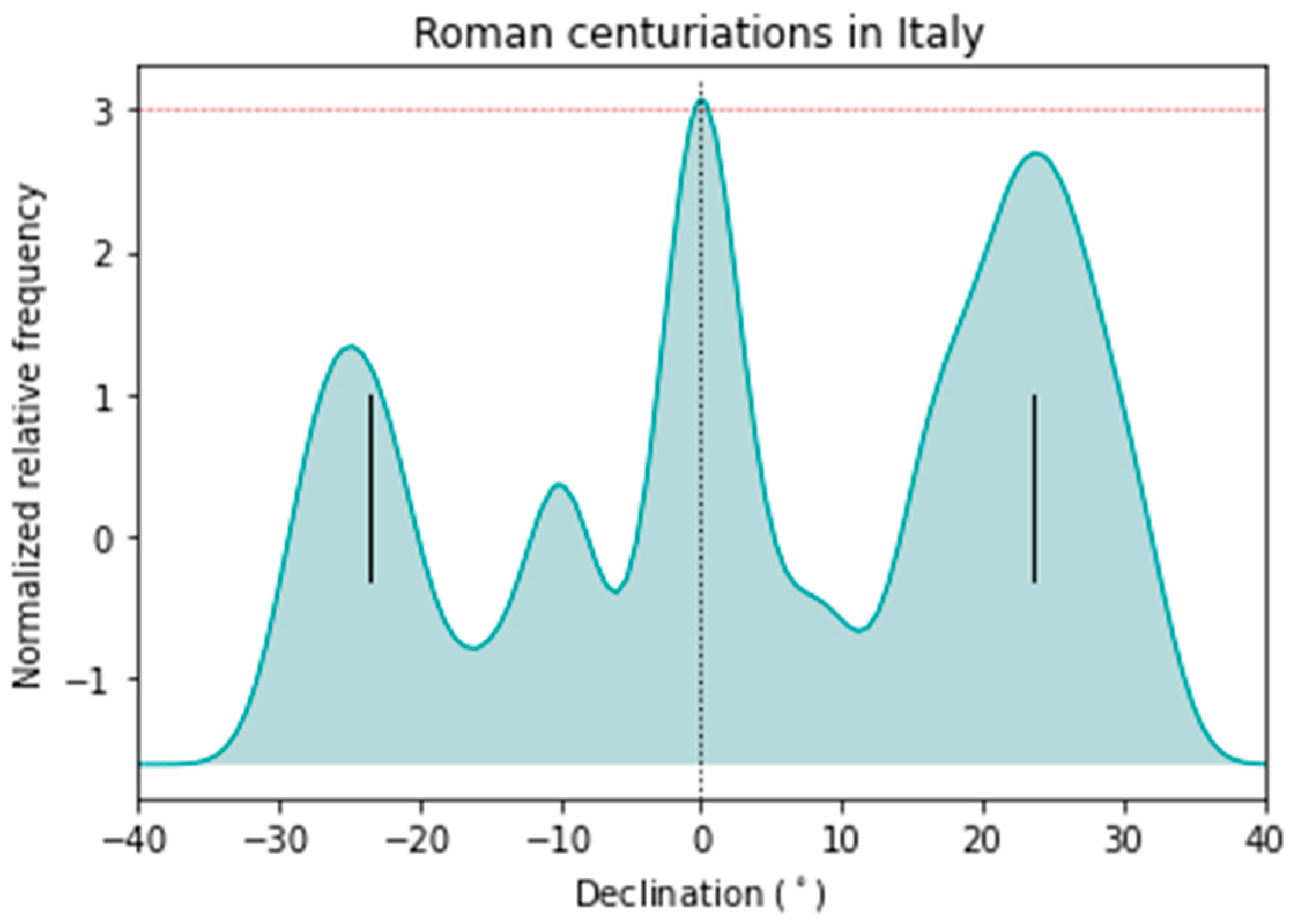Between Land and Sky—A Study of the Orientation of Roman Centuriations in Italy
Abstract
:1. Introduction
Ancient Sources and Previous Works
2. Materials and Methods
3. Results
3.1. Orientation of Centuriations
Exploring the Role of Topography
3.2. Orientation of Roman Towns
4. Discussion
5. Conclusions
Supplementary Materials
Author Contributions
Funding
Acknowledgments
Conflicts of Interest
References
- Ward-Perkins, J.B. Cities of Ancient Greece and Italy: Planning in Classical Antiquity, 1st ed.; Braziller: New York, NY, USA, 1974. [Google Scholar]
- Gilman Romano, D. The orientation of towns and centuriations. In A Companion to the Archaeology of the Roman Republic, 1st ed.; Evans, J.D., Ed.; Wiley-Blackwell: New York, NY, USA, 2013; Chapter 16; pp. 253–267. [Google Scholar]
- Pelgrom, J. The Roman rural exceptionality thesis revisited. MEFRA-Antiquité 2018, 130, 69–103. [Google Scholar] [CrossRef]
- Castagnoli, F. Le Ricerche Sui Resti Della Centuriazione, 1st ed.; Edizioni di Storia e Letteratura: Rome, Italy, 1958. [Google Scholar]
- Lewis, M.J.T. Surveying Instruments in Ancient Greece and Rome, 1st ed.; Cambridge University Press: Cambridge, UK, 2001. [Google Scholar]
- Dilke, O.A.W. Roman Large-scale mapping in the Early Empire. In Cartography in Prehistoric, Ancient, and Medieval Europe and the Mediterranean: The History of Cartography, 2nd ed.; Harley, B., Woodward, D., Eds.; The University of Chicago Press: Chicago, IL, USA, 1987; Volume 1, pp. 212–233. [Google Scholar]
- Chouquer, G. Les centuriations de Romagne orientale: Etude morphologique. MEFRA 1981, 93, 823–862. [Google Scholar] [CrossRef]
- Chouquer, G.; Clavel-Lévêque, M.; Favory, F.; Vallat, J.P. Structures Agraires en Italie Centro-Méridionale: Cadastres et Paysages Ruraux, 1st ed.; École Française de Rome: Rome, Italy, 1987. [Google Scholar]
- Stek, T.D.; Modrall, E.B.; Kalkers, R.A.A.; Van Otterloo, R.H.; Sevink, J. An early Roman colonial landscape in the Apennine mountains: Landscape archaeological research in the territory of Aesernia (Central-Southern Italy). Anal. Archaeol. 2015, 1, 229–291. [Google Scholar]
- Gonzalez-Garcia, C.; Magli, G. Roman city planning and spatial organization. In Handbook of Archaeoastronomy and Ethnoastronomy, 1st ed.; Ruggles, C., Ed.; Springer: New York, NY, USA, 2015; Volume 2, pp. 1643–1650. [Google Scholar]
- Le Gall, J. Les Romains et l’orientation solaire. MEFRA 1975, 87, 287–320. [Google Scholar] [CrossRef]
- Guy, M. Les orientations del parcellaires quadrillés. Rev. Archéologique De Narbonn. 1993, 26, 57–68. [Google Scholar] [CrossRef]
- Somella, P. Italia Antica: L’Urbanistica Romana, 1st ed.; Jouvence: Rome, Italy, 1988. [Google Scholar]
- Decramer, L.R.; Elhaj, R.; Hilton, R.; Plas, A. Approche géométrique des centuriations romaines. Les nouvelles bornes du Bled Segui. Hist. Mes. 2002, 17, 109–162. [Google Scholar]
- Rodríguez-Antón, A.; González-García, A.C.; Belmonte, J.A. An archaeoastronomical approach to Roman urbanism. Orientation of Roman settlements across the Empire. Mediterr. Archaeol. Archaeom. 2018, 18, 89–95. [Google Scholar]
- González-García, A.C.; Rodríguez-Antón, A.; Espinosa-Espinosa, D.; García Quintela, M. Establishing a new order: The orientation of towns built at the age of Augustus. In Archaeoastronomy in the Roman World: Historical & Cultural Astronomy, 1st ed.; Magli, G., González-García, A., Belmonte Aviles, J.A., Antonello, E., Eds.; Springer: Berlin/Heidelberg, Germany, 2019; pp. 85–102. [Google Scholar]
- Rodríguez-Antón, A.; González-García, A.; Belmonte Aviles, J. Astronomy in Roman Urbanism: A Statistical Analysis of the Orientation of Roman Towns in the Iberian Peninsula. J. Hist. Astron. 2018, 49, 363–387. [Google Scholar] [CrossRef]
- Rodríguez-Antón, A.; Belmonte Aviles, J.; González-García, A. Romans in the Near East: The orientation of Roman settlements in present-day Jordan. Mediterr. Archaeol. Archaeom. 2016, 16, 153–160. [Google Scholar]
- Rodríguez-Antón, A.; González-García, A.C.; Belmonte, J.A. Estimating the reliability of digital data acquisition in Cultural Astronomy: Its use in the case of Roman North Africa. J. Skyscape Archaeol. 2017, 3, 191–206. [Google Scholar] [CrossRef]
- Magli, G. On the orientation of Roman towns in Italy. Oxf. J. Archaeol. 2008, 27, 63–71. [Google Scholar] [CrossRef]
- Bertarione, S.V.; Magli, G. Under Augustus’ sign: The role of Astronomy in the foundation of Augusta Praetoria Salassorum. Nexus Netw. J. 2015, 22, 369–391. [Google Scholar]
- González-García, A.C.; García Quintela, M.V.; Rodríguez-Antón, A.; Espinosa-Espinosa, D. The winter solstice as a Roman cultural mark from the origins to Augustus. Environ. Archaeol. 2022, 2053825. [Google Scholar] [CrossRef]
- Magli, G.; Realini, E.; Reguzzoni, M.; Sampietro, D. Uncovering a masterpiece of Roman engineering: The project of Via Appia between Colle Pardo and Terracina. J. Cult. Herit. 2014, 15, 665–669. [Google Scholar] [CrossRef]
- Magli, G. A high-precision GPS survey of Via Appia: Archaeoastronomy-related aspects. Mediterr. Archaeol. Archaeom. 2014, 14, 55–65. [Google Scholar]
- Rodríguez-Antón, A.; Orfila Pons, M.; González-García, A.C.; Belmonte, J.A. The uaratio and its possible use in Roman urban planning to obtain astronomical orientations. In Archaeoastronomy in the Roman World: Historical & Cultural Astronomy, 1st ed.; Magli, G., González-García, A., Belmonte Aviles, J.A., Antonello, E., Eds.; Springer: Berlin/Heidelberg, Germany, 2019; pp. 103–120. [Google Scholar]
- Settis, S. Misurare la Terra: Centuriazione e Coloni Nel Mondo Romano, 1st ed.; Franco Cosimo Panini: Monaco, 1983. [Google Scholar]
- Pelgrom, J. Settlement organization and land distribution in Latin colonies before the Second Punic War. In People, Land and Politics, 1st ed.; de Ligt, L., Northwood, J., Eds.; Brill: Leiden, The Netherlands, 2008; pp. 333–372. [Google Scholar]
- Bradley, G. The nature of Roman strategy in Mid-Republican colonization and road building. In Roman Republican Colonization. Perspectives from Archaeology and Ancient History, 1st ed.; Stek, T.S., Pelgrom, J., Eds.; Palombi: Rome, Italy, 2014; Volume 62, pp. 60–72. [Google Scholar]
- González-García, A.C.; Belmonte, J.A. Which equinox? Archaeoastron. J. Astron. Cult. 2006, 20, 95–105. [Google Scholar]
- Libertini, G.; Lorenz, W. Liber Coloniarum—The Book of the Colonies; Istituto di Studi Atellani: Naples, Italy, 2019. [Google Scholar]
- Franceschelli, C. Reflessioni su la centuriazione romana: Paradigmi interpretativi, valenzia paesaggistica, significato storico. Agri Centauri Int. J. Landsc. Archaeol. 2015, 12, 175–210. [Google Scholar]
- Mateazzi, M. Dinamiche di occupazione della pianura litorale a sud della città di padova (italia) in epoca romana: Scelte insediative e uso del territorio. In Implantations humaines en Milleu litoral Méditerranéen: Facteurs d’Installation et Processus d’Appropiation de l’Espace (Prèhistoire, Antiquité, Moyen Àge), 1st ed.; Mercuri, L., González Villaescusa, R., Bertoncello, F., Eds.; APDCA: Antibes, France, 2014; pp. 329–340. [Google Scholar]
- Menchelli, S. Per la centuriazione dell’ager Firmanus: Analisi integrata di fonti tipologicamente dicerse. Agri Centuriati 2009, 6, 99–114. [Google Scholar]
- Heywhatsthat. Available online: https://www.heywhatsthat.com/ (accessed on 14 November 2022).
- González-García, A.C.; Sprajc, I. Astronomical significance of architectural orientations in the Maya Lowlands: A statistical approach. J. Archaeol. Sci. 2016, 9, 191–202. [Google Scholar] [CrossRef]
- Corti, C. L’ager Nord-Occidentale Della Città di Mutina: Il Popolamento nel Carpigiano e Della Media Pianura dalla Romanizzazione al Tardoantico-Medioevo; L’erma di Bretchsneider: Rome, Italy, 2014. [Google Scholar]
- Monaco, M. Sur la centuriation de l’ager Campanus: La limite sud-est. In De la Terre au Ciel. Paysages et Cadastres Antiques, II; Institut des Sciences et Techniques de l’Antiquité: Besançon, France, 2004; Volume 2, pp. 145–146. [Google Scholar]
- De Simone, G.F. The Dark Side of Vesuvius: Landscape Change and the Roman Economy. Ph.D Thesis, University of Oxford, Oxford, UK, 2014. [Google Scholar]
- Bruno, L.; Amorosi, A.; Curina, R.; Severi, P.; Bitelli, R. Human-landscape interactions in the Bologna area (Northern Italy) during the middle-late Holocene with focus on the Roman period. Holocene 2013, 23, 1560–1571. [Google Scholar] [CrossRef]
- Turchetto, J. La questione del possibile assetto agrario nei territori di Feltria e Bellunum. Quad. Di Archeol. Del Veneto 2006, 23, 109–116. [Google Scholar]
- Orfila Pons, M.; Rodríguez-Antón, A.; Chávez-Álvarez, M.E.; González-García, A.C.; Sánchez López, E.H.; Belmonte, J.A. Determinación de orientaciones de ciudades romanas por medio de la varatio. AESPA 2020, 93, 12–30. [Google Scholar] [CrossRef]
- Bini, M.; Zanchetta, G.A.; Regatieri, E.; Isola, I.; Drysdale, N.; Fabiani, F.; Genovesi, S.; Hellstrom, C. Hydrological changes during the Roman Climatic Optimum in northern Tuscany (Central Italy) as evidenced by speleothem records and archaeological data. J. Quat. Sci. 2020, 35, 791–802. [Google Scholar] [CrossRef]
- González-García, A.C.; Belmonte, J.A. Sacred architecture orientation across the Mediterranean: A comparative statistical analysis. Mediterr. Archaeol. Archaeom. 2014, 14, 95–113. [Google Scholar]
- Magli, G. Etruscan divination and architecture. In Handbook of Archaeoastronomy and Ethnoastronomy, 1st ed.; Ruggles, C., Ed.; Springer: New York, NY, USA, 2015; Volume 2, pp. 1637–1643. [Google Scholar]
- Belmonte, J.A.; González-García, A.C.; Rodríguez-Antón, A.; Perera Betancort, M.A. Equinox in Petra: Land and skyscape in the Nabatean capital. Nexus Netw. J. 2020, 22, 369–391. [Google Scholar] [CrossRef]
- Hannah, R.; Magli, G. The role of the sun in the Pantheon’s design and meaning, Numen-Arch. Hist. Relig. 2011, 58, 486–513. [Google Scholar]
- Richardson, A. Orientation of Roman camps and forts. Oxf. J. Archaeol. 2005, 24, 415–426. [Google Scholar] [CrossRef]
- Mensing, S.A.; Schoolman, E.M.; Tunno, I.; Noble, P.J.; Sagnotti, L.; Florindo, F.; Piovesan, G. Historical ecology reveals landscape transformation coincident with cultural development in central Italy since the Roman Period. Nat. Sci. Rep. 2018, 8, 2138. [Google Scholar] [CrossRef]
- Belmonte, J.A.; Rodríguez-Antón, A.; González-García, A.C. On the orientation of Roman cities in the Illyrian coast: A statistical and comparative study. In Harmony and Symmetry, 1st ed.; Draxler, S., Lippitsch, M.E., Wolfschmidt, G., Eds.; Hamburg Tredition: Hamburg, Austria, 2020; pp. 167–183. [Google Scholar]
- Mateazzi, M. Contributo allo studio dell’ager centuriatus di Atria. In Paesaggi in Movimento, 1st ed.; Richerche dedicate a Guido Rosada; Turchetto, J., Asolati, M., Eds.; Padova University Press: Padova, Italy, 2017; pp. 125–138. [Google Scholar]
- Mateazzi, M. The Structuring of the Landscape in the Low Padua Plain (Italy) during Roman Times: New Contributions from an Archaeomorphological Study of the Territory. J. Anc. Stud. 2012, 3, 307–312. [Google Scholar]
- Mateazzi, M. Il paesaggio centuriato a suddi Padova: Una nuova lettura dallo studio archeomorfologico del territorio. Agri Centauriati 2014, 11, 9–29. [Google Scholar]
- Frasine, M.; Primon, S. La centuriazione di Altino: Nitidezza di segno e labilità di significato. Agri Centauri Int. J. Landsc. Archaeol. 2010, 7, 249–267. [Google Scholar]
- Marinetti, A.; Cresci, G. Ideologia della delimitazione spaziale in area veneta nei documenti epigrafici. In Finem Dare: Il Confine Tra Sacro, Profano e Immaginario; Mercurio: Torino, Italy, 2011; pp. 287–311. [Google Scholar]
- Ninfo, A.; Fontana, A.; Mozi, P.; Ferrarese, F. The map of Altinum, ancestor of Venice. Science 2009, 325, 577. [Google Scholar] [CrossRef] [PubMed]
- Prenc, F.P. Centuriazione e occupazione del territorio di Aquilea: Tra presenze e aussenze. Antiq. Altoadriatiche 2007, 65, 97–126. [Google Scholar]
- Bellini, G.R. L’ager di Aquinum: Ricerca e tutela 2010. Lazio E Sabina 2012, 8, 553–559. [Google Scholar]
- Bellini, G.R.; Trigona, S.L.; Murro, G.; Leone, N. Ager di Aquinum, ricerca e tutela nel 2012. Lazio E Sabina 2014, 10, 185–193. [Google Scholar]
- Fraccaro, P. Intorno ai confini e alla centuriazione degli agri di Patavium e di Acelum. Opuscula 1957, 3, 71–91. [Google Scholar]
- Franceschini, M. Le Ville Romane della X Regio (Venetia et Histria), 1st ed.; LERMA di Bretschiner: Rome, Italy, 1998. [Google Scholar]
- Bosio, L. La centuriazione romana della X Regio. Antich. Altoadriatiche 1986, 28, 143–156. [Google Scholar]
- Miotto, G. I Romani Nelle Alpi: Archeologia del Territorio Nella Provincia di Belluno. Ph.D. Thesis, Università Ca’Foscari Venezia, Venetia, Italy, 2014. [Google Scholar]
- Novello, L.A. Resti di Centuriazione Romana Nella Val Belluna, 1st ed.; Academina Nazionale dei Lincei: Rome, Italiy, 1989. [Google Scholar]
- Montevecchi, G.; Negrelli, C. Antichi Paesaggi. Una Proposta di Valorizzazione Della Centuriazione Romana in Emilia-Romagna, 1st ed.; Istituto per i Beni Artistici Culturali e Natural della Regione Emilia-Romagna: Bologna, Italy, 2009. [Google Scholar]
- Botazzi, G.; Labate, D. La centuriazione nella pianura modenese e carpigiana. In Storia di Carpi: La Città e il Territorio Dalle Origini all’affermazione dei Pio, 1st ed.; Bonacini, P., Ori, A.M., Eds.; Fondazione Cassa di Risparmio di Carpi: Modena, Italy, 2008; pp. 177–209. [Google Scholar]
- Ascari, S. Paesaggi nascosti–Paesaggi ordinari. La centuriazione. In Il Paesaggio Agrario Italiano Protostorico e Antico, 1st ed.; Quaderni 6; Bonini, G., Brusa, A., Cervi, R., Eds.; Edizioni Instituto Alcide Cervi: Reggio Emilia, Italy, 2009; pp. 85–96. [Google Scholar]
- Guandalini, F. La centuriazione in Emilia Romagna. In L’urbanizazzione delle Champagne nell’Italia Antica, 1st ed.; Quilici, N., Quilici Gigli, S., Eds.; L’Erma de Bretschneider: Rome, Italy, 2010; pp. 71–79. [Google Scholar]
- Ruffo, P. La Campania Antica: Appunti di Storia e di Topografia: Parte Prima: Dal Massico-Roccamonfina al Somma-Vesuvio, 1st ed.; DLibri: Napoli, Italy, 2010. [Google Scholar]
- Botazzi, G. Le centuriazione di Ariminum: Prospective di ricercar. In Pro Poplo Ariminense: Epigrafia e Antichita, 1st ed.; Galbi, A., Susini, G., Eds.; Fratelli Lega Editori: Faenza, Italy, 1995; Volume 14, pp. 329–354. [Google Scholar]
- Eusebi, D.; Gardella, R. Claterna Civitas Romana, Rappresentazione del Palinsesto. Ph.D. Thesis, Università di Bologna, Cesena, Italy, 2010. [Google Scholar]
- Gillaumin, J.Y.; Clavel-Leveque, M. Drainage et géometrie dans la centuriation de Cesena. Dialogues D’histoire Anc. 2000, 26, 204–208. [Google Scholar] [CrossRef]
- Delplace, C. La Romanization du Picenum: L’exemple d’Urbs Salvia, 1st ed.; L’école Française de Rome: Rome, Italy, 1993. [Google Scholar]
- Alfieri, N. La centuriazione romana nelle bassi valli del Potenza e del Chienti. Studi Maceratesi 1968, 4, 215–225. [Google Scholar]
- Bacci, M. Centuriazione Romana: Il caso di Firenze (Florentia), 1st ed.; Press & Archeos: Florence, Italy, 2012. [Google Scholar]
- Krizmanich, K. Sulla centuriazione romana dell’Istria. Istria Nobilissima 1981, 14, 181–190. [Google Scholar]
- Marchiori, A. Infrastrutture Territorial e Strutture Insediative dell’Istria Romana: La Divisione Centuriale di Pola e Parenzo in Rapporto ai Grandi Complessi Costieri Istriani: Il Caso Nord Parentino. Ph.D. Thesis, Scuola di Dottorato in Studio e Conservazione dei Beni Archeologici e Architettonici Indirizzo in Scienze Archeologiche, Padova, Italy, 2010. [Google Scholar]
- Marchiori, A. Oltre la Costa: Centuriazione e Insediamento nell’Istria Romana, 1st ed.; Circolo di Cultura Istro-Veneta “Istria”: Trieste, Italy, 2013. [Google Scholar]
- Scafetta, N. Napoli: La Città del Sole e di Pertenope, 2nd ed.; Società dei Naturalisti in Napoli: Naples, Italy, 2021. [Google Scholar]
- Soricelli, G. Divisioni agrarie romane e occupazione del territorio nella piana nocerino-sarnese. In La Romanizzazione della Campania Antica, 1st ed.; Franciosi, G., Ed.; Jovene Editore: Naples, Italy, 2002; pp. 123–130. [Google Scholar]
- Monaco, L. Centuriazione e gestione delle acque. Considerazioni in tema di assetti agrari nell’ager campanus. In La Romanizzazione della Campania Antica, 1st ed.; Franciosi, G., Ed.; Jovene Editore: Naples, Italy, 2002; pp. 87–123. [Google Scholar]
- Ruffo, F. La piana del Sarno (Ager Nucerinus, ager Pompeianus, ager Stabianus): Fonti archeologiche e (ri)letture cartografiche per lo studio delle centuriazioni e della viabilità in etá romana. Agri Centauri J. Landsc. Archaeol. 2015, 12, 9–40. [Google Scholar]
- Camerieri, P. La centuriazione dell’ager Nursinus. In Nursia e L’ager Nursinus, 1st ed.; Sisani, S., Ed.; Edizioni Quasar: Rome, Italy, 2013; pp. 25–34. [Google Scholar]
- Giorgi, E.; Campagnoli, P. La ricostruzione del paesaggio antico nell’Appennino centrale. Alcune considerazioni metodologiche. In Atti del IV Convegno Internazionale di Studi Veleiati (Veleia-Lugagnano Val d’Arda, 20–21 Settembre 2013, 1st ed.; Dall’Aglio, P.L., Franceschelli, C., Maganzani, L., Eds.; Estratto: Bologna, Italy, 2013; pp. 331–344. [Google Scholar]
- Bettinardi, I. Relazione Archeologica: 4.5 Vazzola e l’agro Centuriato; Comune di Vazzola: Vazzola, Italy, 2017. [Google Scholar]
- Dall’Aglio, L. Centuriazione e geografia física. Agri Centuriati 2009, 6, 279–288. [Google Scholar]
- Botazzi, G. Persistenze dell’impianto urbanistico di Regium Lepidi nella città medievale. Alcune osservazioni. In Matilde ed il Tesoro dei Canossa, Catalogo Mostra, 1st ed.; Calzona, A., Ed.; Silvana Editoriale: Milano, Italy, 2009; pp. 392–396. [Google Scholar]
- Storchi, P. Tannetum: Mutamenti ambientali, considerazioni storiche e fotografía aérea pe la localizzazione della ittà e la ricostruzione del territorio. Agri Centuriati 2014, 11, 61–82. [Google Scholar]
- Schmiedt, G. Le centuriazioni di Lucera e di Aecae. L’Universo 1985, 65, 260–277. [Google Scholar]
- Kim, Y. Centuriated Luceria: A Latin colony and its territory. Pap. Br. Sch. Rome 2021, 89, 41–100. [Google Scholar] [CrossRef]
- Campagnoli, P.; Giorgi, E. Assetto territoriale e divisioni agrarie nel Piceno meridionale. Cluana, Pausulae, Urbs Salvia e Asculum. J. Anc. Topogr. 2004, 14, 35–56. [Google Scholar]
- Ruffo, F. Pompei, Nola, Nuceria: Assetti agrari tra la tarda età repubblicana e la prima età imperiale: Documentazione archeologica e questioni di método. In Archeologia: Richerche e Studi Sul Campo: Annali 2011–2012, 1st ed.; Università Degli Studi Suor Orsola Benicasa: Naples, Italy, 2012; pp. 53–126. [Google Scholar]
- Ferro, L.; Magli, G.; Osanna, M. Gromatic Images from New Discoveries in Pompeii. Nexus Netw. J. 2020, 22, 717–733. [Google Scholar] [CrossRef]
- Cristofaro, I.; Silani, M. Approaching skyscape archaeology: A note on method and fieldwork for the case study of Pompeii. Groma 2021, 22, 1–22. [Google Scholar]
- Neglia, G.A. Il paesaggio del Salento leccese. Struttura naturale e forme di antropizzazione. In Messapia: Forma del Territorio e delle Città del Salento Meridionale, 1st ed.; Defilippis, F., Montemurro, M., Eds.; PolibaPress: Bari, Italy, 2012; pp. 148–163. [Google Scholar]
- Camerieri, P. Il catastro di Mevania: Primi studi sull’assetto territoirale della cittá romana. In Invito al Parco, 1st ed.; Trabalza, M.R., Colacicchi, R., Eds.; Foligno: Perugia, Italy, 2007; pp. 147–156. [Google Scholar]
- Cerraudo, G.; Murro, G. Aquinum: Una città romana tra ricerca e prospettive di valorizzazione. AAC 2016, 27, 57–76. [Google Scholar]
- Camerieri, P.; Manconi, D. Le centuriazioni della Valle Umbra da Spoleto a Perugia. Boll. Di Archeol. 2010, 1, 15–39. [Google Scholar]
- Vacilotto, A. Tarvisium romana, riflesioni di archeologia urbana. QdaV 2011, 27, 115–123. [Google Scholar]








Disclaimer/Publisher’s Note: The statements, opinions and data contained in all publications are solely those of the individual author(s) and contributor(s) and not of MDPI and/or the editor(s). MDPI and/or the editor(s) disclaim responsibility for any injury to people or property resulting from any ideas, methods, instructions or products referred to in the content. |
© 2023 by the authors. Licensee MDPI, Basel, Switzerland. This article is an open access article distributed under the terms and conditions of the Creative Commons Attribution (CC BY) license (https://creativecommons.org/licenses/by/4.0/).
Share and Cite
Rodríguez-Antón, A.; Magli, G.; González-García, A.C. Between Land and Sky—A Study of the Orientation of Roman Centuriations in Italy. Sustainability 2023, 15, 3388. https://doi.org/10.3390/su15043388
Rodríguez-Antón A, Magli G, González-García AC. Between Land and Sky—A Study of the Orientation of Roman Centuriations in Italy. Sustainability. 2023; 15(4):3388. https://doi.org/10.3390/su15043388
Chicago/Turabian StyleRodríguez-Antón, Andrea, Giulio Magli, and Antonio César González-García. 2023. "Between Land and Sky—A Study of the Orientation of Roman Centuriations in Italy" Sustainability 15, no. 4: 3388. https://doi.org/10.3390/su15043388
APA StyleRodríguez-Antón, A., Magli, G., & González-García, A. C. (2023). Between Land and Sky—A Study of the Orientation of Roman Centuriations in Italy. Sustainability, 15(4), 3388. https://doi.org/10.3390/su15043388




